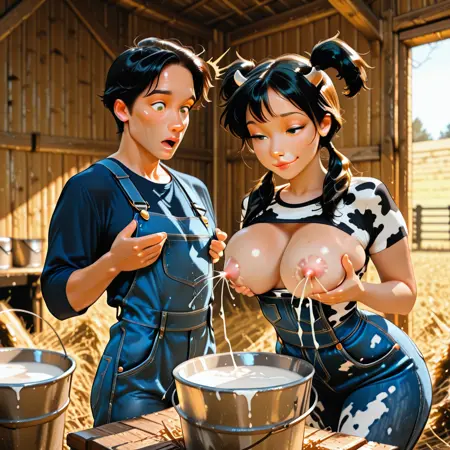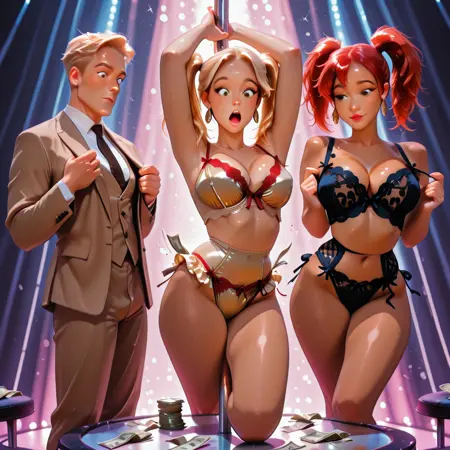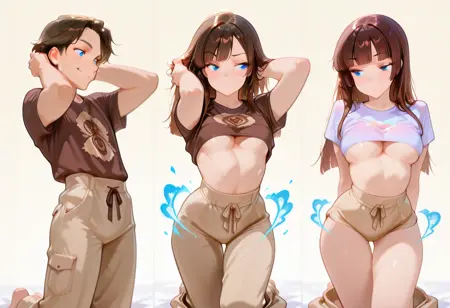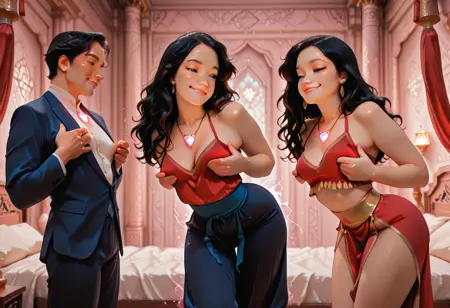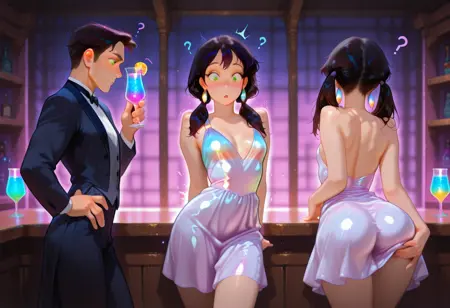M2F Transformation
Details
Download Files
About this version
Model description
Generates M2F/TSF cartoon sequences. This tends to produce 3-character sequences at typical landscape 3:2 resolution (1216x832) but it will produce longer sequences at 16:9 ratio (1344x768) or ultra widescreen (1536x640). It can do very nice 2-character ("before after") shots too, and these are about all you can get in square or portrait resolutions. With wide and ultra wide pics it will go up to 5-6 characters with good sequence consistency.
It can also produce F2F transformation sequences, particularly if you turn the strength down a bit. I've added a few of these to the gallery for 4.0 & 5.0.
Recommended strength: 0.8
Tags: gender transformation Lately I usually start masterpiece, gender transformation, man, woman, androgynous. The number of characters really depends on the resolution and poses, and the gender span mostly depends on what masculine and feminine tags are included. Most models are heavily weighted to females and won't put a man in there unless you really push it.
I don't find 2girls, 1boy, etc tags to be useful, I've tried on checkpoints without the lora and most of them don't seem to pay much attention to these either. But especially if you don't have many other tags, you can try tweaking here.
Optional: magical effects, drinking potion, glowing book etc. It's getting enough of this type of thing now it seems to be able to guess what to do.
Negative: people in backgroundbecause it likes reflecting people into every nook that it can.
Post your results! I'd love to see your creations.
Version 5 Update 🎉
I went through a lot of different iterations trying to produce something that was consistently better than v4, and I think I finally got it. Let me know how it works for you.
Version guide:
[1.0] First release, Pony only. Likes to generate 4-5 characters standing and facing forward, with capacity for 3 or 6. Obsolete, pretty much, but very clean and easy to work with if you like the type of image it creates.
[1.5] First Illustrious version. Loosened it up a bit so it's easier to get characters who are not standing and facing forward in a line. Widened the variety of characters it can handle by a lot. Supports some magical special effects. Better than 1.0 for practically everything.
[2.0] This one has more of a 2.5D bias than the other versions. Really opened it up, it's now trained on a lot more concepts and magical effects. Very versatile. Due to the variety though you may need a little negative prompting against magical effects etc that you don't want to pop in.
[3.0] Has a lot more training on magical props like wands, potions, and mysterious devices. There's also more variety of poses and scenes. Characters take up more space which tends to shorter sequences, typically 3-4 characters with capacity for 2 or 5. It's also a bit stronger than previous versions, I like to run it at 0.8 or 0.85, while previous versions were great at 1.0 strength. Even more than 2.0, it may just be a bit "much".
[4.0] Cleaned up some image quality issues, now works better with more checkpoints. Images look pretty clean at strength 1.0 now but get a little weird as it tries to transform more aggressively. Overall it's even more versatile than 3.0.
[5.0] I've been tending to include any images that were really hard to generate into the next version's training data, but I think some of these have just been confusing the model. So this version is built on a more consistent dataset, and I feel like it hits more consistently. It may end up being less flexible but maybe not. Training images are way better than past versions both in image quality and "feel", does it tell a real story, or is it just technically correct.
Future: It's really mature now, but I can add even more magic props and ideas. I may split it up into separate magical/technological loras or something, to keep out some of the weirder glitches.
Check out the galleries to see what earlier versions can do!
Tips:
Lora strength 0.8 or 0.85 works pretty well (try 1.0 strength for versions 2.0 and earlier). Going lower is more likely to create all female sequences (which can still be fun), potentially more creative sequences, more out of order steps. Going higher can give more masculine starting characters, but also tends to produce longer sequences. At very high levels it will degrade the image.
More steps also seems to help the sequence, up to a point at least. I.E. it probably produces a clean image and sequence with 15 steps or so but 20, 25, 30 may be better still.
I feel like a low CFG gives the Lora more freedom to work. I like about 4 on most checkpoints.
If you want to combine with a character lora, turn its strength down, maybe half. It will want to make every character look like the lora which will conflict with this one trying to do its thing.
The tag "holding object" is really interesting. The model will just plug something in, often it fits the scene.
The tag "diorama" also produces some pretty neat effects.
For better or worse, realistic and semi-realistic models are not great at androgyny without help. Illustration models do best.
It likes to hallucinate extra figures into the background. Recommend (blurred background) in the prompt and (people in background) in the negative.



